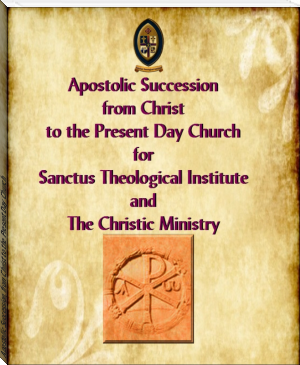Principles of Teaching by Adam S. Bennion (feel good novels .TXT) 📖

- Author: Adam S. Bennion
- Performer: -
Book online «Principles of Teaching by Adam S. Bennion (feel good novels .TXT) 📖». Author Adam S. Bennion
4. Application. Having selected his aim, the teacher knows the result he should like to have follow his lesson, in the lives of his pupils. He knows, too, their tendencies and their needs. In giving attention to application he is merely making a survey of the possible channel into which he can direct his pupils' activities. In considering application he asks, "Of what use will this material be in the experience of my pupils?" The test-application is the real test—both of the subject matter presented and of the effectiveness of the presentation.
5. Questions. Finally, lesson preparation is not complete unless the teacher has formulated a few thought-provoking questions which go to the very heart of the lesson. The question is the great challenge to the seeker after truth. It is easy to ask questions, but to propound queries that stir pupils to an intellectual awakening is a real art. Surely no preparation can be fully complete unless it involves:
The selection of an aim. The orderly organization of material. The collecting of rich illustrations. The pondering of facts to their application. The formulating of at least a few thoroughly stimulating questions.Can we not agree to these steps as fundamental in the proper preparation of our lessons in all of our Church organizations?
With the subject matter well in mind—the work behind the scenes completed, the teacher is then prepared for the problem of presentation—is ready to appear on the stage of class activity. The first outstanding problem in lesson presentation is that of the Point of Contact. This is a phrase variously interpreted and often misunderstood. Perhaps it is not the happiest expression we could wish, but it is so generally used and is so significant when understood that we ought to standardize it and interpret it as it affects our Church work.
When a class assembles for recitation purposes its members present themselves with all kinds of mental attitudes and mind content. The various groups of a Mutual class may have been engaged in all sorts of activities just before entering their classroom. One group may have been discussing politics; another may have been engaged in a game of ball; a third may have been practicing as a quartette; and still a fourth may have been busy at office work. Facing such a collection of groups stands a teacher who for an hour or more has dismissed all temporal matters, and has been pondering the spiritual significance of prayer. Evidently there is a great mental chasm between them. Their coming together and thinking on common ground involves the Point of Contact. There must be contact if an influence for good is to be exerted. Either the teacher must succeed in bringing the boys to where he is "in thought," or he must go to "where they are."
Teachers in Bible lessons all too frequently hurry off into the Holy Land, going back some two thousand years, and leaving their pupils in Utah and in the here and the present. No wonder that pupils say of such a teacher, "We don't 'get' him." To proceed without preparing the minds of pupils for the message and discussion of the lesson is like planting seed without having first plowed and prepared the ground.
In the Bible lesson, it would be easy to bridge over from the interests of today to those of Bible days. Suppose our lesson is on Joseph who was sold into Egypt. Instead of proceeding at once with a statement as to the parentage of Joseph, etc., we might well center the interests of these various-minded boys on a current observation of today—a wonderfully fine harvest field of grain. They have all seen that. Make a striking observation relative to the grain, or put a question that will lead them to do that for you. Having raised an issue, you continue by inquiring whether or not the same conditions have prevailed elsewhere and at other times. Did they prevail in the days of Israel? The step then to the story of Joseph's dream, etc., is an easy one.
This illustration, though simple and more or less crude, indicates that to establish a point of contact, we must reach out to where the pupil now is, and lead easily and naturally to where you would have him go. Surely we cannot presume that he has already traveled the same intellectual road that we have gone over.
Suppose we face a group of adolescent boys to teach them a lesson on the importance of their attending church. If we proceed with a preachment on their duties and obligations, we are quite certain to lose their interest. Boys do not like to be preached at.
We know, however, that they are interested in automobiles. By starting out with some vital observation or question out of the automobile world, we may count on their attention. Following the discussion thus raised, we might then inquire the purpose of the garages that we find along all public highways. We could dwell upon the significance of repairs in maintaining the efficiency of cars. Now we are prepared for the query, Is it not essential that we have spiritual garages for the souls of men, garages where supplies and repairs may be had?
The "gas" of faith. The "oil" of consolation. The "adjustment" of repentance. The "charging" of our spiritual batteries, etc.Once led into the subject, boys can be made to see that spiritual problems are even more vital than material ones.
The point of contact established, we next face the matter of Lesson Statement. The subject matter must either be in mind already because of home preparation, or the teacher must supply it. In the smaller classes the teacher generally will have to tell in good part what he wishes to convey; in the larger classes, there are the possibilities of home preparation, topical reports, the lecture, and the socialized recitation built up by questions and discussions. It is not intended here to discuss the various methods of lesson presentation—the thought being simply that in some way the lesson statement must be presented.
Then there is the problem of connecting up the present lesson with those that have already been presented. The review is a vital factor in fixing in the mind the relative value of material covered.
Then, too, there is the matter of questioning to test knowledge and stimulate discussion, together with the weaving in of illustrative material that has already been thought out or which may suggest itself as the lesson progresses. If, as all this material has been presented, the application has been made sufficiently clear to the pupils, the presentation is complete; otherwise avenues of action should be pointed out, care being taken to stimulate rather than to moralize.
In conclusion, then, we have the matter of preparation as follows:
Preparation
subject matter: As it involves
presentation: 1. The Aim Point of Contact 2. Organization Lesson Statement 3. Illustration Review 4. Application Illustration 5. Questions Application
Questions and Suggestions—Chapter XIV
1. Discuss the helpfulness of having a definite procedure in the matter of lesson preparation.
2. Point out the differences between lesson preparation and lesson presentation.
3. Name and discuss the essential steps in preparing a lesson.
4. To what extent would you favor adopting these steps as the fundamental processes?
5. Discuss the meaning and significance of "The Point of Contact."
6. Why is some kind of lesson statement a prerequisite to a good recitation?
7. Show how this statement may be made.
8. What do you consider your most valuable device in the preparation of a lesson?
9. Discuss the importance of filing away the material looked up in the preparation of the regular work of teaching.
10. Indicate some of the best methods of filing.
Helpful References
Betts, How to Teach Religion; Weigle, Talks to Sunday School Teachers; Thorndike, Principles of Teaching; Strayer and Norsworthy, How to Teach; Earhart, Types of Teaching; Betts, Classroom Method in Management; Bagley, Classroom Management.
CHAPTER XV ORGANIZING A LESSONOutline—Chapter XV
A review of the steps in lesson preparation.—The values of outlining.—Objections answered.—Outlining a means, not an end.—The essentials in outlining.—An illustrative outline on prayer.
Preparing a lesson is no easy matter, particularly for those teachers who are new to the calling. There are those, of course, for whom reading an assigned chapter through constitutes a preparation, but to the successful teacher this preliminary reading is only the initial step in the process. Adequate preparation involves the following questions:
What aim shall I select out of the material available as the focus for my day's work?
How shall I build about that aim a body of facts that will establish it as a fundamental truth in life?
How shall I illustrate the truths presented so that they will strike home in the experiences of my boys and girls?
How shall I make sure that members of the class will go out from the recitation to put into practice the teachings of the day?
What questions ought I to ask to emphasize the outstanding points of my lesson?
What method of presentation can I most safely follow to make my lesson effective?
How may I discipline my class so that no disturbances will interfere with our discussions?
Reduced to simple terms, the matter of preparation together with presentation, involves the problems of
Organization Aim Illustration Application Methods of presentation QuestioningIt is difficult to single out any one factor and treat it as if it were independent of the others—teaching is a complex art with all of these factors inseparably contributing to the results desired—but, for purposes of clearness, may we not proceed to give attention to each in its turn that in the end the teaching process may the more definitely stand out in all its aspects?
For convenience, then, let us in this chapter consider the problem of organization. How to outline a lesson is one of the most fundamental considerations involved in the teaching process. In fact, it is doubtful whether there is any one more helpful attainment than the ability clearly to outline subject matter. It not only enables the teacher to proceed systematically, thereby insuring clearness and adequate treatment of a lesson, but it makes it so easy and profitable for a class to follow the discussion. Outlining to teaching is what organization is to business. Just as the aim points out the goal we seek, so the outline indicates the route we shall follow to attain the goal. Outlining is simply surveying the road before the concrete is laid.
Occasionally a teacher objects to outlining on the ground that it is too mechanical—that it destroys spontaneity and the flow of the Spirit of the Lord. It has always seemed to the writer that the Spirit of the Lord is quite as pleased to follow a straight path as it is to follow a crooked one. Outlining is not in any sense a substitute for inspiration—it is merely a guarantee, by way of preparation, that the teacher has done his part and can in good conscience ask for that spiritual aid and guidance which he then is entitled to. The fact that order is a law of heaven rather indicates that there is no divine injunction against outlining.
Of course, outlining is not an end in itself—it is a means merely to more systematic procedure. Two difficulties frequently attach to outlining: one is that the outline is made so complex that it hinders rather than helps in the matter of clearness; the other is that a teacher may become "outline bound," in which case his teaching becomes mechanical and labored.





Comments (0)